General Information
about the
Knights of Columbus
What the Knights are all about
How the Knights are structured as an organization
The Ceremonials of the Order
Robes and Jewels of Council Officers
Hierarchy of the Knights of Columbus
What the Knights are all about
The Knights of Columbus is a lay Catholic family fraternal
service organization. Membership in the Knights of Columbus is open to all practical
Catholic men in communion with the Holy See, age eighteen and above. The term practical
Catholic implies that a person accepts and abides by the Commandments of God and the
precepts and tenets of the Catholic church.
 On October 2, 1881, Father Michael J. McGivney,
29-year-old assistant pastor at St. Mary's Church in New Haven, Connecticut, brought
together a group of laymen with whom he discussed his dream for a Catholic fraternal
benefit society. It not only would assist widows and orphans of deceased members through
its life insurance program, but also would boost members' sense of pride in their Catholic
religion, then frequently challenged in the anti-Catholic climate of 19th-century America.
Father McGivney and his associates met several more times over the next several months to
continue planning, and the new organization --the Knights of Columbus -- was formally
launched in early February, 1882. On October 2, 1881, Father Michael J. McGivney,
29-year-old assistant pastor at St. Mary's Church in New Haven, Connecticut, brought
together a group of laymen with whom he discussed his dream for a Catholic fraternal
benefit society. It not only would assist widows and orphans of deceased members through
its life insurance program, but also would boost members' sense of pride in their Catholic
religion, then frequently challenged in the anti-Catholic climate of 19th-century America.
Father McGivney and his associates met several more times over the next several months to
continue planning, and the new organization --the Knights of Columbus -- was formally
launched in early February, 1882.
The officers of the new Catholic organization chose the name Knights of Columbus to honor
Christopher Columbus, the Catholic discoverer of America. The word knights is also
significant. We are ever mindful of the knightly qualities of spirituality and service to
church that is embodied in the Knights of Columbus. The Order has evolved into a service
organization with a strong family orientation.
By the end of 1897 the Order was thoroughly rooted in New
England, along the upper Atlantic seaboard and into Canada. Within the next eight years it
branched out from Quebec to California, and from Florida to Washington.
 The Knights of Columbus remains headquartered in New Haven, but is now present with nearly
12000 Councils in the United States, Canada, the Philippines, Mexico, and several other
countries.
The Knights of Columbus remains headquartered in New Haven, but is now present with nearly
12000 Councils in the United States, Canada, the Philippines, Mexico, and several other
countries.
One of the primary missions of the Knights of Columbus is to
support local charities. The Knights are a familiar sight around town during the annual
Tootsie Roll® drive, which raises funds for charities that support the retarded and
handicapped. We also support other fund raising drives to aid local parishes and
charities.
The Knights of Columbus promotes family values by providing
numerous activities throughout the year that the entire family can participate in.
Additionally, the organization provides an opportunity to ensure that a knight's family is
provided for in the event of his death.
Here is short list of reasons you may want to join the
Knights of Columbus:
- An opportunity to become part of the world's largest Catholic
fraternal organization
- A great way to make a personal contribution to the Church and
community through charity and fraternity
- Active participation in Council activities serves as a
"school of leadership" which will enable you to develop qualities that enhance
your strengths and abilities
- A sense of "belonging" in an organization that
shares your religious beliefs and brings to together like-minded men joined in a common
cause
- Concerns for your family and your retirement years can be
addressed by the Orders optional, low-cost life insurance
- A sense of pride, knowing that the Knights of Columbus is
second to none in support of our Holy Father, our Bishops and Priests, and our fellow man
Hierarchical Structure of the Knights of
Columbus
All members of the Knights of Columbus belong to a
particular Council, and any group of at least thirty men may apply to found a new Council
in their area. The highest elected officer of each Council is the Grand Knight, who, with
the other Council Officers, is elected by the membership each year. The Grand Knight
appoints various Program Directors and Chairmen to run the Council's activities for the
year. All Council activities except Membership activities, fall into one of five Program
Areas, each with a Director. The five Directors of Church Activities, Community
Activities, Council Activities, Family Activities and Youth Activities report to a General
Programs Director, who in turn reports to the Grand Knight.
Several Councils within the same geographic area join
together in a District under the guidance of the District Deputy and his assistant, the
District Warden.
The District Officers are appointed by the State Deputy, the
highest elected officer of the State Council. State Officers and Program Chairmen are
analogous to those at the Council level and coordinate the activities of all the Councils
throughout the State. Each Spring, the State Deputy hosts a Convention to elect officers
and conduct other State business. Every Grand Knight and one elected Delegate represent
every Council in the state at this Convention.
The highest level within the Knights of Columbus is the Supreme Council, headed by the Supreme
Knight. At the Supreme Convention each summer, State Deputies and Representatives from
each State, Territory, or Country meet to conduct business concerning the international
operation of the Order.
Ceremonials of the Order
There are four "Degrees" of Knighthood within the
Knights of Columbus. The initiation ceremonies into each of these Degrees (the ceremonies
themselves are also called "Degrees") are the only facets of the Order which are
not made known to non-members. Each of the Degrees is designed to exemplify one of the
four Principals of the Order: Charity, Unity, Fraternity and Patriotism. The Degrees must
be taken in order.
Every applicant must take the First, or Membership, Degree
before he can be considered a Member of the Knights of Columbus. Once he has taken his
First Degree, he becomes a member in good standing in the Order. To reach full Knighthood,
members must also take the Second and Third Degrees, and all members are strongly
encouraged to do so. Members must have taken the Third degree to be elected to Council
offices or to enter into the Fourth Degree.
Once a man has been a member of the Knights of Columbus for
a year and has taken his Third Degree, he is eligible to join a Fourth Degree Assembly.
The Fourth Degree has its own structure separate from that of the Council. Fourth Degree
Assemblies gain their membership from Third Degree members of several Councils within a
larger geographic area. The most visible members of the Order are often the Fourth Degree
Color Corps, with their colorful capes, chapeaux and sabers.
Each Council Officer has his own ceremonial robe and a metal
emblem called a jewel worn on a ribbon around the neck. Officers' robes are all of the
general design called the Columbus Robe. It is a flowing robe with inserted yoke, usually
white. The opening is in the back with invisible clasps. There are inner or coat sleeves
and outer or flowing sleeves. There is a standing collar, open in front, and a cowl or
hood. Three belt straps are provided around the waist for a cincture or belt containing
two tabs. The cincture is worn so that the tabs hang down along the left side of the body,
but not on the hip. The tabs are ended in fringe. The mantle, as prescribed for the State
Deputy, Grand Knight and Chancellor, is a sleeveless coat with large arm holes, and is
worn over the Columbus Robe.
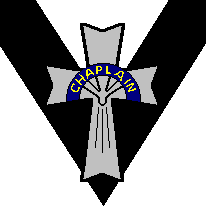 The Chaplain provides spiritual guidance to the Council. His emblem is the
Cross, worn on a black ribbon. The robe, too, is black with black trimming and yoke with
white projecting collar. The cincture is black with silver fringe. The Chaplain provides spiritual guidance to the Council. His emblem is the
Cross, worn on a black ribbon. The robe, too, is black with black trimming and yoke with
white projecting collar. The cincture is black with silver fringe.
 The
Grand Knight is the Chief Executive Officer of the Council and is responsible for all
aspects of Council operation. He presides over Council meetings and is ex-officio member
of all committees. His emblem, the Anchor carried on a purple ribbon, is indicative of
Columbus, the Mariner. It has also been a variant form of the Cross for centuries. His is
a royal purple robe with white cincture with silver fringe. A purple mantle with white
roll collar is also worn. The
Grand Knight is the Chief Executive Officer of the Council and is responsible for all
aspects of Council operation. He presides over Council meetings and is ex-officio member
of all committees. His emblem, the Anchor carried on a purple ribbon, is indicative of
Columbus, the Mariner. It has also been a variant form of the Cross for centuries. His is
a royal purple robe with white cincture with silver fringe. A purple mantle with white
roll collar is also worn.
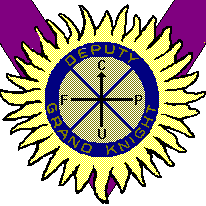 The Deputy Grand Knight acts on behalf of the Grand Knight in his absence and also serves
as General Programs Director. His emblem, the Compass, was also used by Columbus, the
Mariner. The Knights of Columbus Compass, with its points being Charity, Unity, Fraternity
and Patriotism, is known as the Compass of Virtue; its 32 flame-like rays represent the 32
virtues which may be possessed by men. It is hung from a purple ribbon. His robe is the
same as the Grand Knight, but without the mantle.
The Deputy Grand Knight acts on behalf of the Grand Knight in his absence and also serves
as General Programs Director. His emblem, the Compass, was also used by Columbus, the
Mariner. The Knights of Columbus Compass, with its points being Charity, Unity, Fraternity
and Patriotism, is known as the Compass of Virtue; its 32 flame-like rays represent the 32
virtues which may be possessed by men. It is hung from a purple ribbon. His robe is the
same as the Grand Knight, but without the mantle.
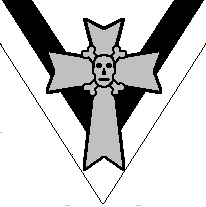 The Chancellor is the third ranking Council Officer. He is in charge of Vocations and
indoctrinating new members into Council activities. The Chancellor usually acts as Council
Activities Chairman as well. His emblem is the Isabella Cross, with Skull and Crossbones;
it is worn on a black over white ribbon. The Cross is self-explanatory, while the Skull
and Crossed Bones are symbolic of man's mortality. The Chancellor wears a black robe
trimmed with white and a white cincture with silver fringe. He also wears a black mantle
with white roll collar.
The Chancellor is the third ranking Council Officer. He is in charge of Vocations and
indoctrinating new members into Council activities. The Chancellor usually acts as Council
Activities Chairman as well. His emblem is the Isabella Cross, with Skull and Crossbones;
it is worn on a black over white ribbon. The Cross is self-explanatory, while the Skull
and Crossed Bones are symbolic of man's mortality. The Chancellor wears a black robe
trimmed with white and a white cincture with silver fringe. He also wears a black mantle
with white roll collar.
 The
Financial Secretary records all money transactions, issues and collects bills, issues
membership cards, and is otherwise responsible for all financial matters of the Council
except those allocated to the Treasurer. His emblem is a Crossed Key and Quill. The Key
has always been associated with an office concerned with money, safekeeping and secrecy.
The Quill is the symbol of a scribe - a recordkeeper - one who writes letters, documents,
etc. This jewel is worn on a white over yellow ribbon. His robe is black, trimmed with
black, and a white cincture with silver fringe. The
Financial Secretary records all money transactions, issues and collects bills, issues
membership cards, and is otherwise responsible for all financial matters of the Council
except those allocated to the Treasurer. His emblem is a Crossed Key and Quill. The Key
has always been associated with an office concerned with money, safekeeping and secrecy.
The Quill is the symbol of a scribe - a recordkeeper - one who writes letters, documents,
etc. This jewel is worn on a white over yellow ribbon. His robe is black, trimmed with
black, and a white cincture with silver fringe.
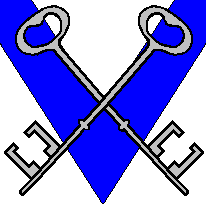 The Treasurer keeps all funds, maintains the accounts of the Council, and issues Council
checks upon receipt of a proper voucher from the Financial Secretary. Crossed Keys worn on
a blue ribbon are symbolic of his complete authority over funds, particularly
responsibility for their safekeeping. His robe is black, trimmed with black, and a white
cincture with silver fringe.
The Treasurer keeps all funds, maintains the accounts of the Council, and issues Council
checks upon receipt of a proper voucher from the Financial Secretary. Crossed Keys worn on
a blue ribbon are symbolic of his complete authority over funds, particularly
responsibility for their safekeeping. His robe is black, trimmed with black, and a white
cincture with silver fringe.
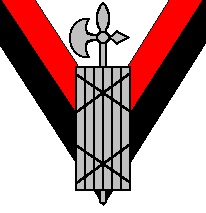 The
Warden assures that all members at meetings possess the current membership card. He is
custodian of all Council property except funds and is in charge of properly setting up the
Council Chamber. He directs the activities of the Inside and Outside Guards. His emblem,
an Axe Bound with Rods, known as a Faces, was traditionally carried by the guards or
protectors of Roman magistrates as a symbol of authority. The Warden ideally has and
exercises that authority. The ribbon is colored red over black. His robe is black trimmed
with scarlet with a scarlet cincture with silver fringe. The
Warden assures that all members at meetings possess the current membership card. He is
custodian of all Council property except funds and is in charge of properly setting up the
Council Chamber. He directs the activities of the Inside and Outside Guards. His emblem,
an Axe Bound with Rods, known as a Faces, was traditionally carried by the guards or
protectors of Roman magistrates as a symbol of authority. The Warden ideally has and
exercises that authority. The ribbon is colored red over black. His robe is black trimmed
with scarlet with a scarlet cincture with silver fringe.
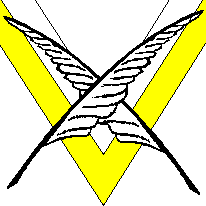 The Recorder keeps the minutes of the meetings, conducts correspondence as directed by the
Grand Knight, and keeps official historic documents of the Council. In the absence of the
Grand Knight and Deputy Grand Knight, he presides at Council meetings. Crossed Quills hung
from a white over yellow ribbon are symbolic of his responsibilities for letter and
document (records) writing and preservation. His robe is black, trimmed with black, with a
white cincture with silver fringe.
The Recorder keeps the minutes of the meetings, conducts correspondence as directed by the
Grand Knight, and keeps official historic documents of the Council. In the absence of the
Grand Knight and Deputy Grand Knight, he presides at Council meetings. Crossed Quills hung
from a white over yellow ribbon are symbolic of his responsibilities for letter and
document (records) writing and preservation. His robe is black, trimmed with black, with a
white cincture with silver fringe.
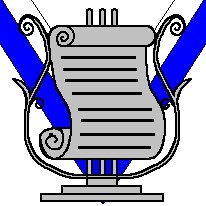 The Lecturer provides entertainment for the members after meetings, particularly the
second meeting of the month, which is our social meeting, and handles certain other major
social events of the Council such as Family Dinners. His emblem consists of Lyre and
Scroll. These are traditionally symbols of music and literature and the arts. Hence, the
Lecturer is in charge of entertainment. His ribbon is white over blue. The Lecturer wears
a black robe with national blue trimming and blue cincture with silver fringe.
The Lecturer provides entertainment for the members after meetings, particularly the
second meeting of the month, which is our social meeting, and handles certain other major
social events of the Council such as Family Dinners. His emblem consists of Lyre and
Scroll. These are traditionally symbols of music and literature and the arts. Hence, the
Lecturer is in charge of entertainment. His ribbon is white over blue. The Lecturer wears
a black robe with national blue trimming and blue cincture with silver fringe.
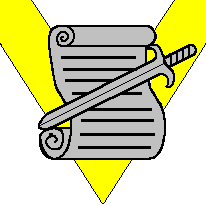 The Advocate is the Chief Legal Officer of the Council, resolving procedural matters,
acting as parliamentarian, and otherwise handling all legal activities. His emblem is the
Scroll with Crossed Sword hung from a yellow ribbon. The Scroll is emblematic of legal
literature and law, while the Sword indicates the power to defend and enforce the law. The
Advocate's robe is black with golden yellow trim and yellow cincture with silver fringe.
The Advocate is the Chief Legal Officer of the Council, resolving procedural matters,
acting as parliamentarian, and otherwise handling all legal activities. His emblem is the
Scroll with Crossed Sword hung from a yellow ribbon. The Scroll is emblematic of legal
literature and law, while the Sword indicates the power to defend and enforce the law. The
Advocate's robe is black with golden yellow trim and yellow cincture with silver fringe.
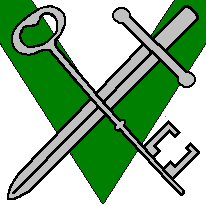 The Trustees (three in number) oversee the financial transactions of the Council, review
all bills and financial reports and audit the Council's financial records semi-annually.
Their emblems, Crossed Key and Sword, indicate this financial authority and are worn on
green ribbons. Trustees wear black robes trimmed in green.
The Trustees (three in number) oversee the financial transactions of the Council, review
all bills and financial reports and audit the Council's financial records semi-annually.
Their emblems, Crossed Key and Sword, indicate this financial authority and are worn on
green ribbons. Trustees wear black robes trimmed in green.
 The Inside Guard (1) and Outside Guards (2) are charged with the security of the Council
Chamber and assist the Warden in meeting the duties of his Office. Their emblems, Crossed
Key and Axe hung from a white ribbon, represent their power as sentries at the door. Their
robes are gray with black trim and yoke. The cincture is also black with silver fringe.
The Inside Guard (1) and Outside Guards (2) are charged with the security of the Council
Chamber and assist the Warden in meeting the duties of his Office. Their emblems, Crossed
Key and Axe hung from a white ribbon, represent their power as sentries at the door. Their
robes are gray with black trim and yoke. The cincture is also black with silver fringe.
At Knights of Columbus
functions, dignitaries in attendance are addressed and introduced in strict order of rank
from highest to lowest. The first words of any speech are usually some variation of
"Reverend Father, Worthy State Deputy, ... Brother Knights, Lovely Ladies, and
Beautiful Children," according to who are actually present. This is known as
"The Litany" and is usually presented in its complete form only once by the
toastmaster or master of ceremonies, with other speakers abbreviating it to varying
extents to save time and repetition.
Order of Precedence
- Hierarchy
- Clergy
- State Deputy
- Vice Supreme Master
- State Officers
- Masters of the Fourth Degree
- Immediate Past State Deputy
- Past State Deputies (by seniority)
- Former Masters
- Executive Staff
- District Deputies
- Supreme Council Insurance Directors or Field Agents
- State Directors
- Chapter Presidents
- State Chairmen
- Wardens to the State Deputy
- District Wardens
- District Marshals
- Grand Knights
- Faithful Navigators
- Past Chapter Presidents
- Past Grand Knights
- Past Faithful Navigators
- Chapter Officers
- Council Officers
- Assembly Officers
Parade Formation
When walking in a parade formation (either two or four
abreast) the higher ranking person always precedes a lower ranking person. Usually ladies
walk alongside their men. When Past State Deputies or past Grand Knights are in parade
formation, the Immediate Past Officer takes precedence. The others follow in order of
seniority with the most senior one being first.
Procession Formation
When walking in a procession formation (always two abreast)
the lowest ranking person always precedes a higher ranking person, with the highest
ranking person being last in line. When Past State Deputies or past Grand Knights are in
procession formation, the one with the least seniority precedes the others in line, with
the one exception that the Immediate Past State Deputy or Immediate Past Grand Knight will
be the last in the line of Past State Deputies or Past Grand Knights, with the most senior
one preceding him.

[ Church of The Good Shepard K of C Council #13161] [Back to the previous page]
For information on this web site send mail to webmaster
This page created by Knights of Columbus Council #13161
Copyright K of C Council #13161 ©
2011 all rights reserved |

